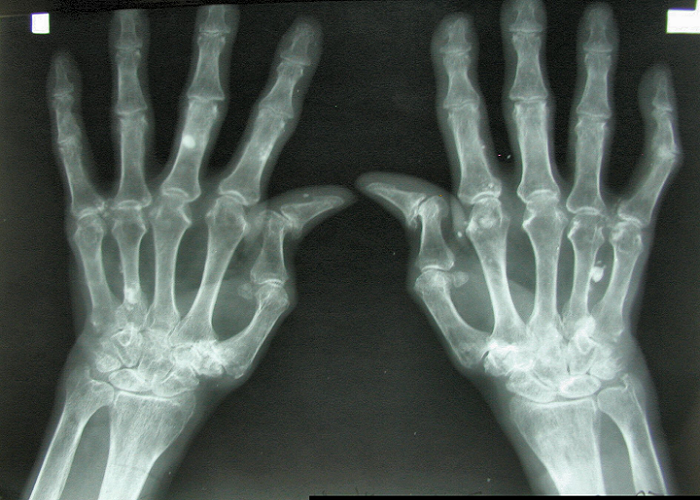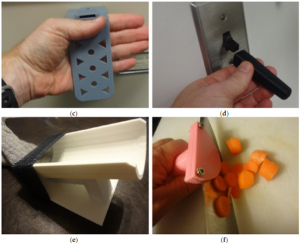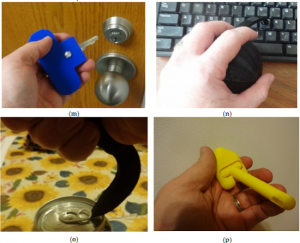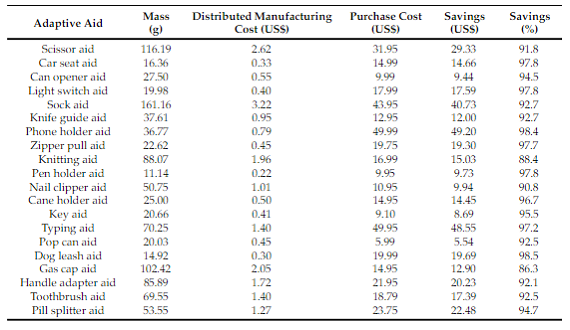How Cost Effective are 3D Printed Adaptive Aids for Arthritis Patients?

Arthritis breaks down cartilage between joints, leading to pain, stiffness, and swelling. [Public domain image: Jojo]
 Arthritis patients would definitely benefit from a cost reduction of adaptive aids, which is where a trio of researchers from Michigan Technological University come in. Nicole Gallup, Jennifer K. Bow, and Joshua M. Pearce completed a study, titled “Economic Potential for Distributed Manufacturing of Adaptive Aids for Arthritis Patients in the U.S.,” that evaluated if distributed manufacturing, by way of 3D printing, would be economically viable for fabricating lower cost adaptive aids for arthritis.
Arthritis patients would definitely benefit from a cost reduction of adaptive aids, which is where a trio of researchers from Michigan Technological University come in. Nicole Gallup, Jennifer K. Bow, and Joshua M. Pearce completed a study, titled “Economic Potential for Distributed Manufacturing of Adaptive Aids for Arthritis Patients in the U.S.,” that evaluated if distributed manufacturing, by way of 3D printing, would be economically viable for fabricating lower cost adaptive aids for arthritis.
The abstract reads, “By 2040, more than a quarter of the U.S. population will have diagnosed arthritic conditions. Adults with arthritis and other rheumatic conditions earn less than average yet have medical care expenditures that are over 12% of average household income. Adaptive aids can help arthritis patients continue to maintain independence and quality of life; however, their high costs limit accessibility for older people and the poor. One method used for consumer price reduction is distributed manufacturing with 3-D printers. In order to assess if such a method would be financially beneficial, this study evaluates the techno-economic viability of distributed manufacturing of adaptive aids for arthritis patients.“
The study focused on aids for arthritis of the hands, as these are the most likely candidates for 3D printing. The team used common, inexpensive PLA to fabricate 20 adaptive aids on low-cost desktop 3D printers – specifically delta-style RepRap Athena II kits from Michigan’s 3D4EDU – to determine their distributed manufacturing costs.

Case study arthritis adaptive aids: (c) drawer aid; (d) light switch aid; (e) sock aid; (f) knife guide aid
All of the adaptive aids were found for free on open source 3D printing design website MyMiniFactory, sliced with the recommended settings on Cura, and the open source 3D printers were run with no heated beds or enclosures to keep the cost down, as well as to ensure realistic mechanical properties and operating conditions. With the exception of manual support material removal and assembly, no other post-processing was required.
The 20 adaptive aids included items that would be able to help users complete such everyday tasks as splitting pills, clipping their nails and brushing their teeth, zipping up jackets and opening up pop cans, and turning on a light switch.
The researchers chose the adaptive aids based on six criteria:
- They had freely available STLs posted on MyMiniFactory.
- They contained the source code for straightforward device customization.
- They were licensed with an open-source compatible license or designer requests as defined by the Open Source Hardware Association.
- They could be fabricated on a consumer grade 3D printer.
- They were able to be 3D printed and used if manufactured from PLA.
- They had a functionally equivalent commercialized proprietary product, or a clear application for arthritis patients.
“These products were tested for function and compared to those that offer similar functions on the U.S. market,” the researchers wrote. “These results are evaluated to determine the potential for distributed manufacturing to assist arthritis patients and conclusions are drawn.”
The researchers found that each adaptive aid was in fact “able to perform the technical mechanical function for which it was designed,” but determined that further work is necessary in order to find out where the devices would be most applicable in terms of patient populations. Then, they set about determining the overall cost of 3D printing the 20 assistive aids.
Filament costs and labor costs were excluded, and the actual 3D printing time was also not a factor, because “the filament cost dominates the operating costs and the printers can be comfortably operated without observation or labor intervention.”
“The energy use of the 3-D printer was found to be about 40 W during printing,” the researchers stated. “With energy use during translation (movement without printing of the head) and warming up to printing temperature included, the 3-D printer uses about 0.06 kW/h or less than 1 penny per hour to operate.”
The researchers also massed all of the 3D printed components after printing and post-processing was complete to help with the economic comparison. But, while the mass is pretty dependent on the slicing settings, the cost of a single aid will only vary by about 10% from new user setting variations, which changes the percent savings but doesn’t hurt the conclusions.
“For example, the toothbrush aid had a mass of 69.55 g. If it was printed with a mass of 76.5 g (a 10% increase) it would result in a cost of US$1.53, which is a 91.8% savings rather than 92.5%,” the researchers explained.
As it turns out, using distributed manufacturing to 3D print adaptive aids can actually save arthritis patients a decent amount of money.
“The financial savings for the patients ranged from 86.3–98.5% per product manufactured with a consumer desktop 3-D printer, with average savings of over 94%. Overall, the 20 example adaptive aids could be printed for a 1 kg of plastic, which costs $20, while on average each single adaptive aid would save the patient more than $20,” the researchers concluded. “3-D printing all 20 adaptive aids would save about $400, which means only 30 adaptive aids alone could fully cover the capital cost of the printer along with the filament and electricity costs.”
This means that Medicare patients could potentially 3D print their own adaptive aids for less money than their 20% co-payments on prescribed DMEs.
“Policy makers as well as philanthropists should consider funding the open-source design of arthritis aids that have not already been developed,” the researchers concluded. “As arthritis is going to be an even more prevalent problem in the future, the application of distributed manufacturing represents a means to economically help society adapt to some of the increased costs associated with the disease.”
Discuss this and other 3D printing topics at 3DPrintBoard.com or share your thoughts below.
Subscribe to Our Email Newsletter
Stay up-to-date on all the latest news from the 3D printing industry and receive information and offers from third party vendors.
Print Services
You May Also Like
Low-cost “Suzy” Polymer Powder 3D Printer is Faster and Cheaper than Past Models
Polish laser powder bed fusion (LPBF) firm Sinterit has released a follow-up to its predecessors, Lisa and Nils, called Suzy, a $19,490 printer equipped with a 30W fiber diode laser....
India’s $58M Space Fund Is a Boon for AM Innovation
India’s space industry is picking up serious momentum. With a projected $44 billion space economy by 2033, the country is aggressively expanding its capabilities, fostering private-sector participation, and reducing its...
Japanese Advanced Manufacturing Capabilities Grow in Europe with Sodick’s Purchase of Prima Additive
The global economy is currently undergoing a reshuffling in terms of what gets manufactured where. In large part, this trend is being driven by new geopolitical alliances and the need...
Bosch Invests €6M into Serial Auto Part 3D Printing
German industrial conglomerate Robert Bosch GmbH, the world’s largest supplier of automotive parts, has announced a new investment into Nuremberg, Germany additive manufacturing (AM) facility. The nearly €6 million in...





























